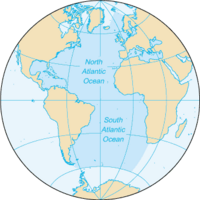
Photo from wikipedia
Abstract Fossil ostracode assemblages were investigated in three sediment cores from the Chukchi Plateau, in the western Arctic Ocean, in order to reconstruct its late Quaternary paleoceanographic history. The cores… Click to show full abstract
Abstract Fossil ostracode assemblages were investigated in three sediment cores from the Chukchi Plateau, in the western Arctic Ocean, in order to reconstruct its late Quaternary paleoceanographic history. The cores were retrieved from water depths of 435–741 m, within the range of modern Atlantic Water (AW). The ostracode abundance shows distinct glacial/interglacial fluctuations, suggesting the suppression of benthic bioproductivity during glacial periods, probably associated with the development of perennial sea ice. Based on the modern ostracode distribution in the Arctic Ocean, 11 common ostracode taxa out of a total of 33 are related to specific water mass or sea ice conditions. Analyses of key ostracode species and a benthic foraminifera species, Cassidulina teretis, reveal a pronounced faunal turnover between MIS 3 and MIS 1. A distinct assemblage dominated by Polycope spp. And accompanied by otherspecies preferring Arctic Intermediate Water (AIW) (Microcythere medistriatum, Pseudocythere caudata, Cytheropteron sedovi, C. scoresbyi, and Pedicythere spp.) characterizes the period between late MIS 5 and MIS 3, whereas MIS 1 is characterized by a rise in Krithe spp. and two species associated with AW (Cytheropteron perlaria and Cassidulina teretis). The faunal turnover indicates an upward shift of AIW and adecline of the influence of warm AW during the period between late MIS 5 and MIS 3, presumably caused by a weakening or cessation of the westward dispersion of AW. The distributions of two sea-ice related species, Acetabulastoma arcticum and Rabilimis mirabilis, indicate minimal perennial sea-ice cover and probably summer sea-ice-free conditions throughout MIS 1 and the development of a summer sea-ice margin environment during interglacial/interstadial periods.
Journal Title: Marine Micropaleontology
Year Published: 2021
Link to full text (if available)
Share on Social Media: Sign Up to like & get
recommendations!